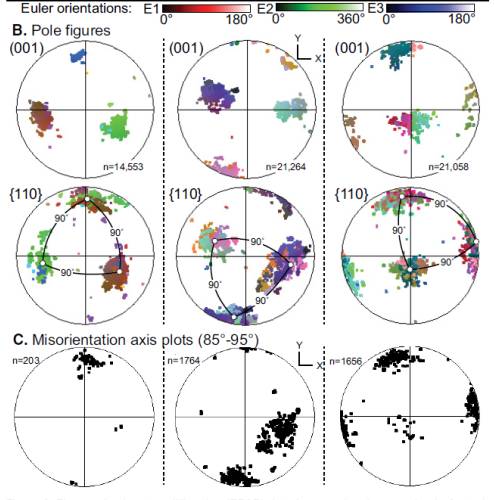|
Tai Tektite
"It present evidence of reidite and ZrO2 in granular
zircon within Muong Nong-type tektites from Thailand, providing new insights.
Tektites are drops of glassy "impact" melt found in areas called strewn fields.
The Australasian field spans 1000s of km across the Indian, Southern, and
western equatorial Pacific oceans, with onland finds from Thailand to Antarctica.
MN-type tektites are high-silica glass (~80 wt. % SiO2), have a layered structure,
a high abundance of vesicles, high volatile and H2O contents, and a variety
of relict minerals. Phases in Australasian MN-type tektites include lechatelierite,
coesite, and stishovite; quartz, zircon, and other minerals with suspected
shock damage have been identified via X-ray asterism. The absence of baddeleyite,
combined with geochemical and microstructural data, has been cited to infer
that Australasian MN-type tektites represent lower temperature melts compared
to other tektites.
Samples: Granular zircon grains in MN-type tektites from Thailand,
previously analyzed for U-Pb age by secondary ion mass spectrometry (SIMS),
were characterized using backscattered electron (BSE), cathodoluminescence
(CL) imaging, and elec-tron backscatter diffraction (EBSD).
Results: Each zircon is polycrystalline with a ‘granular’ texture,
with mean neoblast diameters of 1.1 μm. Some neoblasts are concentrically
zoned in CL. Inclusions of ZrO2 range up to ~1 μm across; most are located
near neoblasts edges, rather than in cores. No other phases were observed.
Neoblasts in each grain are systematically aligned in three crystallographic
orientations. Each grain comprises three distinct orientation clusters that
are mutually perpendicular, with coincidence among (001) and {110} poles.
High-angle misorientation axes (85-95°) show that neighbor-pair pixels in
EBSD maps are systematically clustered, and align with poles to (001) and
{110} of neoblasts. ZrO2 inclu-sions index as zircon in the same orientation
as the surrounding neoblast. The inclusions are likely poorly ordered, and
appear electron transparent."
My Conclusion:
The evidence of former zircon-reidites in Tai-tektites is further evidence
of the origin of the melts with contact to the supracrustal basement, which
was influenced by high pressure. Since all glassy tektite melts worldwide
have a proven composition of volcanic rocks, an impact origin is excluded.
So far it has never been proven that tektites have a composition of a target
rock. Also the general consensus that tektites represent completely melted
supracrustal material is not prove.
|

"Electron backscatter diffraction (EBSD) data for granular zircon
grains in Australasian
Muong Nong–type (MN-type) tektites. A: Maps showing crystallographic orientations
in
Euler coordinate space. Elliptical areas without data are secondary ion
mass spectrometry
(SIMS) pits. B: Pole figures showing data from maps in A for (001) and
{110}. Angular separations
of 90° are shown for {110}. C: Plots showing high-angle (85° to 95°) misorientation
axes.
Misorientation axes coincide with poles for (001) and {110}. Stereonets
are equal area, lower
hemisphere projections in sample x-y-z reference frame."
Source: Aaron J. Cavosie et al.
|
 |
References:
Reidite and ZrO2 in MUONG NONG-TYPE Australian Tektites and
the significance of granular zircon in siliceous melt
A. J. Cavosie -- Lunar and Planetary Science XLVIII (2017) 1806.pdf
New clues from Earth’s most elusive impact crater: Evidence of Reidite
in Australasian Tektites from Thailand
A. J. Cavosie et al. -- The Geological Society of America
New clues from Earth’s most elusive impact crater: Evidence of Reidite
in Australasian Tektites from Thailand
A. J. Cavosie et al. -- GSA Data Repository item
2018049
|